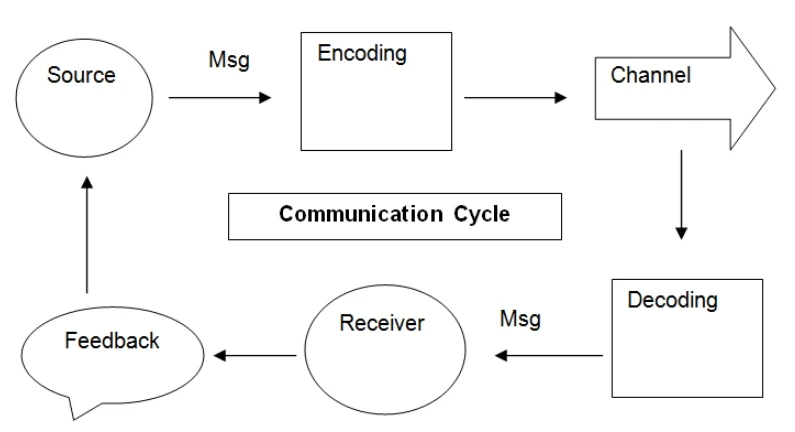Communication Skills – Class 10 IT CBSE
📌 What is Communication?
- Communication is the process of exchanging ideas, thoughts, and information between two or more people.
- It involves a sender, a message, and a receiver.
🌟 Importance of Communication Skills
- Helps in expressing ideas clearly.
- Builds strong relationships.
- Increases confidence.
- Important in schools, offices, interviews, teamwork, etc.
📚 Types of Communication
- Verbal Communication
➤ Uses spoken or written words.
Examples: Talking, Telephone, Email, Chat, Letter. - Non-Verbal Communication
➤ Uses body language, facial expressions, gestures, posture, eye contact.
➤ Helps understand feelings without words. - Visual Communication
➤ Uses pictures, signs, charts, diagrams, maps to share information.
Example: Traffic signs, Posters.
📝 Methods of Communication
- Formal Communication
➤ Follows official rules and formats.
Example: Meetings, official letters, emails at the workplace. - Informal Communication
➤ Friendly and casual communication.
Example: Talking with friends or family.
✅ Elements of Effective Communication
- Clear Message – Message should be simple and understandable.
- Active Listening – Listen carefully to the speaker.
- Feedback – Response given after receiving a message.
- Proper Tone and Body Language – Express positively.
- Correct Medium – Use the best method (phone, mail, face-to-face).
🚫 Barriers to Effective Communication
- Language Barriers – Not understanding each other’s language.
- Noise – Disturbance in the surroundings.
- Emotional Barriers – Fear, anger, shyness.
- Cultural Barriers – Different cultures may cause misunderstandings.
- Lack of Attention – Not listening properly.
🔑 7 Cs of Effective Communication
- Clear – Use simple words.
- Concise – Be brief, avoid long sentences.
- Concrete – Use specific facts and examples.
- Correct – Use correct grammar and facts.
- Coherent – Message should be logical and organized.
- Complete – Give all necessary information.
- Courteous – Be polite and respectful.
👂 Listening Skills
- Active Listening means listening carefully and giving full attention.
- Tips:
- Maintain eye contact.
- Nod or give feedback.
- Don’t interrupt.
🗣️ Speaking Skills
- Speak clearly and confidently.
- Use polite language.
- Avoid slang or abusive words.
- Think before speaking.
✍️ Writing Skills
- Organize your thoughts before writing.
- Use correct grammar, punctuation, and spelling.
- Keep sentences short and clear.
- Use appropriate format for letters, emails, etc.
📖 Reading Skills
- Improve vocabulary by reading books, newspapers.
- Understand the main idea and purpose.
- Read with focus and concentration.
Previous Year Questions
Multiple Choice Questions (1 Mark Each)
- What is the origin of the word "communication"? [CBSE 2022]
A) Communicate
B) Communicare
C) Compute
D) Computer - Which type of words should be used for good communication? [CBSE 2022]
A) Acronyms
B) Technical
C) Jargons
D) Simple - What is a positive facial expression? [CBSE 2022]
A) Frowning
B) Maintaining eye contact
C) Smiling continuously
D) Rolling eyes - Which of the following is not an element of the communication cycle? [CBSE 2023]
A) Channel
B) Receiver
C) Time
D) Sender - Which communication method does not require any language to understand? [CBSE 2023]
A) Verbal
B) Non-Verbal
C) Visual
D) None of these - What is the importance of effective communication in the workplace? [CBSE 2025]
A) Reducing office expenses
B) Enhancing team collaboration
C) Increasing employee vacation days
D) Improving office aesthetics - Which of the following is a barrier to effective communication? [CBSE 2024]
A) Active listening
B) Noise
C) Positive feedback
D) Clear language - What type of communication involves gestures and facial expressions? [CBSE 2025]
A) Verbal communication
B) Written communication
C) Non-verbal communication
D) Digital communication - Which element in the communication cycle ensures the message is understood? [2025]
A) Sender
B) Receiver
C) Feedback
D) Channel - Which of these is not a non-verbal cue? [CBSE 2023]
A) Tone of voice
B) Eye contact
C) Written words
D) Body posture
Short Answer Questions (2 Marks Each)
- Explain any two barriers to effective communication with examples:
- Language Barrier: Miscommunication due to unfamiliar language.
- Emotional Barrier: Fear or stress can prevent clear expression. - How does feedback improve effective communication?
- Confirms message understanding.
- Helps correct misunderstandings. - Describe two methods to overcome communication barriers:
- Use simple language and visuals.
- Encourage active listening and respectful conversation. - What is the role of body language in communication?
- Shows confidence and interest.
- Includes gestures and posture. - How can feedback improve communication?
- Ensures message is correctly understood.
- Supports two-way communication. - Describe two methods to overcome communication barriers:
- Use a translator or images.
- Respect others’ opinions and emotions.
Long Answer Questions (4 Marks Each)
- Differentiate between verbal and non-verbal communication:
- Verbal: Spoken or written (e.g., meetings, emails).
- Non-Verbal: Body expressions (e.g., smiling, nodding). - Importance of active listening in communication:
- Encourages understanding and trust.
- Prevents conflicts.
- Requires attention and feedback. - Four elements of the communication cycle:
- Sender: Creates the message.
- Message: Actual information.
- Channel: Medium of delivery.
- Receiver: Person interpreting it. - Importance of body language in communication:
- Reflects emotions.
- Builds connection.
- Includes gestures, posture, eye contact.
Subscribe to My Channel




